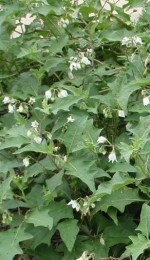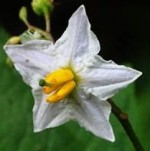 Horsenettle is not a true nettle and is in the nightshade family along with potatoes, tomatoes, peppers and eggplant. It is native to southeastern United States but has spread throughout most of the country and is considered a noxious weed in several states. It grows well in sunny sites with moist to dry soil and is especially common in disturbed areas such as roadsides, vacant lots, abandon fields, the edges of woodlands, and gardens. All parts of the plant are poisonous although the ripe berries are less so and are beneficial to wildlife. The stems and leaves are rarely eaten by mammals, however, because of their toxicity and spines. Horsenettle can be very troublesome in the vegetable garden because they harbor Colorado potato beetles and serve as host for several diseases including pepper and tomato viruses.
Horsenettle is not a true nettle and is in the nightshade family along with potatoes, tomatoes, peppers and eggplant. It is native to southeastern United States but has spread throughout most of the country and is considered a noxious weed in several states. It grows well in sunny sites with moist to dry soil and is especially common in disturbed areas such as roadsides, vacant lots, abandon fields, the edges of woodlands, and gardens. All parts of the plant are poisonous although the ripe berries are less so and are beneficial to wildlife. The stems and leaves are rarely eaten by mammals, however, because of their toxicity and spines. Horsenettle can be very troublesome in the vegetable garden because they harbor Colorado potato beetles and serve as host for several diseases including pepper and tomato viruses.

 Description: This herbaceous perennial weed has a branching stem that grows up to four feet high and bears white star-shaped hairs and spines that can penetrate the skin and cause significant pain. The simple, alternate leaves are 6” long by 3” wide, are lobed or toothed, and have hairs on both surfaces. They resemble the leaves of eggplant but have spines running along the midvein on the underside of each leaf and on the short petioles. The star-shaped flowers also resemble those of eggplant, with their five white to purple petals
Description: This herbaceous perennial weed has a branching stem that grows up to four feet high and bears white star-shaped hairs and spines that can penetrate the skin and cause significant pain. The simple, alternate leaves are 6” long by 3” wide, are lobed or toothed, and have hairs on both surfaces. They resemble the leaves of eggplant but have spines running along the midvein on the underside of each leaf and on the short petioles. The star-shaped flowers also resemble those of eggplant, with their five white to purple petals  surrounding a yellow cone-shaped center composed of five anthers. The flowers are produced in clusters on the upper branches of the plant during summer for four to six weeks. The fruits are berries about ½” in diameter and resemble cherry tomatoes. They contain 40 to 120 seeds and are green at first but turn yellow and wrinkled as they mature. The root system consists of creeping, underground rhizomes that are responsible for vegetative reproduction of the plant.
surrounding a yellow cone-shaped center composed of five anthers. The flowers are produced in clusters on the upper branches of the plant during summer for four to six weeks. The fruits are berries about ½” in diameter and resemble cherry tomatoes. They contain 40 to 120 seeds and are green at first but turn yellow and wrinkled as they mature. The root system consists of creeping, underground rhizomes that are responsible for vegetative reproduction of the plant.

 Control: The hand-pulling of horsenettle is made difficult by both the spiny nature of the stem and leaves, and the extensive root system which can produce new plants from a small piece left behind in the soil. Since herbicides are not very effective against horsenettle, hand digging is the best way to control the weed. Gloves should be worn and care should be taken to dig deeply and sift the soil for broken root pieces over 1 cm in length. Glyphosate, Dicamba and 2,4-D have limited effectiveness but are the best herbicides available for control of this weed.
Control: The hand-pulling of horsenettle is made difficult by both the spiny nature of the stem and leaves, and the extensive root system which can produce new plants from a small piece left behind in the soil. Since herbicides are not very effective against horsenettle, hand digging is the best way to control the weed. Gloves should be worn and care should be taken to dig deeply and sift the soil for broken root pieces over 1 cm in length. Glyphosate, Dicamba and 2,4-D have limited effectiveness but are the best herbicides available for control of this weed.